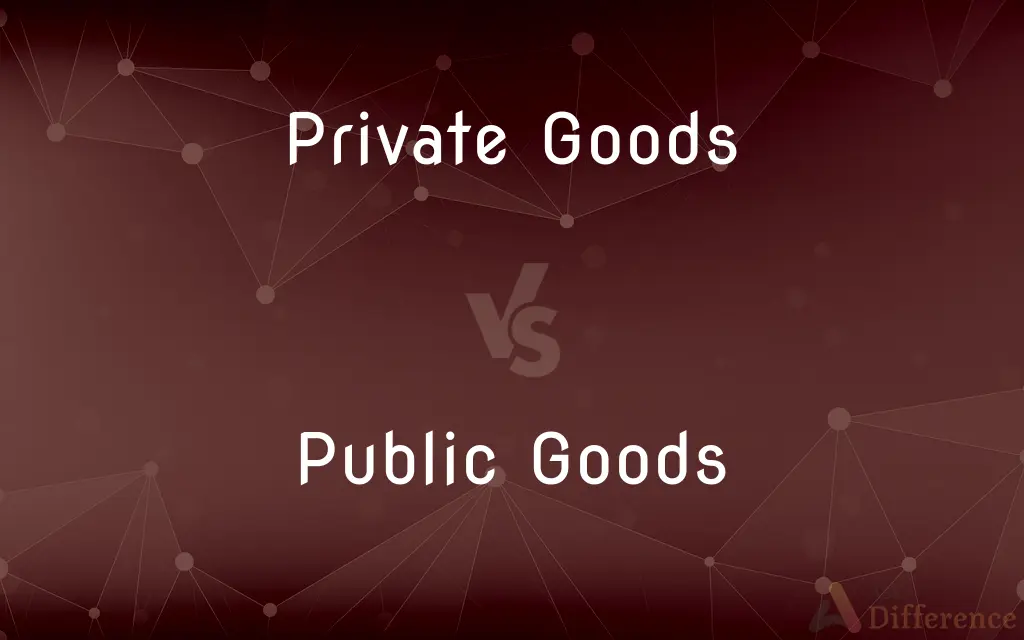Private Goods vs. Public Goods — What's the Difference?
Edited by Tayyaba Rehman — By Fiza Rafique — Published on December 18, 2023
Private Goods are excludable and rivalrous in consumption, while Public Goods are non-excludable and non-rivalrous.

Difference Between Private Goods and Public Goods
Table of Contents
ADVERTISEMENT
Key Differences
Private Goods are items or services that are primarily produced and consumed in a market setting. These goods have two key characteristics: they are excludable and rivalrous. Being excludable means that those who do not pay or have access can be prevented from using the good. Being rivalrous means that one person's consumption of the good reduces its availability for another person. For example, if someone buys a sandwich (a Private Good), another person cannot consume that same sandwich.
On the other hand, Public Goods are items or services consumed by the public at large and are typically funded by taxes. Their defining characteristics are non-excludability and non-rivalrous consumption. This means that use by one individual does not reduce availability to others, and no one can be effectively excluded from using the good. For instance, clean air is a Public Good. Everyone benefits from it, and one person breathing the air doesn't prevent another from doing the same.
The differentiation between Private Goods and Public Goods is pivotal in economic theory and public policy. Private Goods are often associated with individual benefits and are provided by market mechanisms, where price acts as a rationing device. On the contrary, because Public Goods are available to all and cannot be restricted, they can result in what's known as the "free rider" problem, where individuals can benefit from the good without having to pay for it.
It's essential to recognize that not all goods fit neatly into these categories. There are some goods that fall between the two, like club goods or common resources. However, understanding the distinction between Private and Public Goods is crucial as it helps inform decisions about how resources should be allocated and goods should be provided.
Comparison Chart
Excludability
Excludable
Non-excludable
ADVERTISEMENT
Rivalry in Consumption
Rivalrous
Non-rivalrous
Provider
Typically private sector
Typically government or collective entities
Funding Mechanism
Purchase by consumers
Taxes or public funding
Example
Sandwich, shoes
Clean air, public parks
Compare with Definitions
Private Goods
Items purchased and used by individual consumers.
A car is a Private Good since the owner can restrict others from using it.
Public Goods
Services or goods where there's no competition in consumption.
Public radio broadcasts are Public Goods as one's listening doesn't prevent others from doing the same.
Private Goods
Goods that are excludable and diminish upon use.
A candy bar is a Private Good because if one person eats it, another cannot.
Public Goods
Assets typically funded by taxation and not by individual consumers.
Public roads are Public Goods since they're financed by taxpayers and open to all.
Private Goods
Products primarily provided through market transactions.
A pair of jeans is a Private Good because it's bought from a store.
Public Goods
Goods that are non-excludable and available for all to use.
National defense is a Public Good, benefiting all citizens.
Private Goods
Assets that can be restricted from those who haven't paid.
A movie ticket is a Private Good because only ticket-holders can watch the movie.
Public Goods
Commodities where one's consumption doesn't hinder another's usage.
A public fireworks display is a Public Good since multiple people can watch simultaneously.
Private Goods
Commodities where consumption by one affects its availability for another.
A bottle of water is a Private Good as its consumption reduces its availability.
Public Goods
Items that people can't be effectively barred from using.
A public park is a Public Good because everyone can enjoy it without reducing its availability.
Common Curiosities
What is a common example of a Public Good?
Clean air is a Public Good as everyone can benefit from it without depleting it.
Who typically provides Public Goods?
Public Goods are often provided by governments or collective entities.
What's a key difference between Private Goods and Public Goods?
Private Goods are excludable and rivalrous, while Public Goods are non-excludable and non-rivalrous.
Why are Public Goods often funded by taxes?
Since Public Goods are non-excludable, it's hard to charge individuals directly, making taxes a common funding mechanism.
What's the "free rider" problem related to Public Goods?
The "free rider" problem arises when individuals can benefit from a Public Good without contributing to its cost.
Can a service be a Private Good?
Yes, services like private tutoring or personal training are Private Goods.
Can you provide an example of a Private Good?
A loaf of bread is a Private Good because once someone buys and consumes it, it's gone for others.
How are Private Goods typically funded?
Private Goods are usually funded by individual consumers purchasing them.
Are all goods either Private or Public?
No, some goods like club goods or common resources don't fit neatly into either category.
Do Private Goods always come with a price tag?
Typically, yes, as Private Goods are excludable and consumers need to pay to access them.
Is a lighthouse a Public Good?
Yes, a lighthouse is a classic example of a Public Good because all ships can benefit without reducing its service for others.
Are national parks considered Public Goods?
Generally, yes, though they might charge a fee, the benefits of conservation and environment preservation are Public Goods.
Why are Public Goods challenging for market provision?
Because they're non-excludable and non-rivalrous, it's hard to charge for them, leading to the "free rider" problem.
How is rivalry associated with Private Goods?
Rivalry implies that the consumption of a Private Good by one individual reduces its availability for another.
Can Public Goods be provided by the private sector?
While Public Goods are typically government-provided, the private sector can offer them, often subsidized or incentivized by the government.
Share Your Discovery

Previous Comparison
Aldi Stores vs. Lidl Stores
Next Comparison
Polar Dielectrics vs. Nonpolar DielectricsAuthor Spotlight
Written by
Fiza RafiqueFiza Rafique is a skilled content writer at AskDifference.com, where she meticulously refines and enhances written pieces. Drawing from her vast editorial expertise, Fiza ensures clarity, accuracy, and precision in every article. Passionate about language, she continually seeks to elevate the quality of content for readers worldwide.
Edited by
Tayyaba RehmanTayyaba Rehman is a distinguished writer, currently serving as a primary contributor to askdifference.com. As a researcher in semantics and etymology, Tayyaba's passion for the complexity of languages and their distinctions has found a perfect home on the platform. Tayyaba delves into the intricacies of language, distinguishing between commonly confused words and phrases, thereby providing clarity for readers worldwide.














































